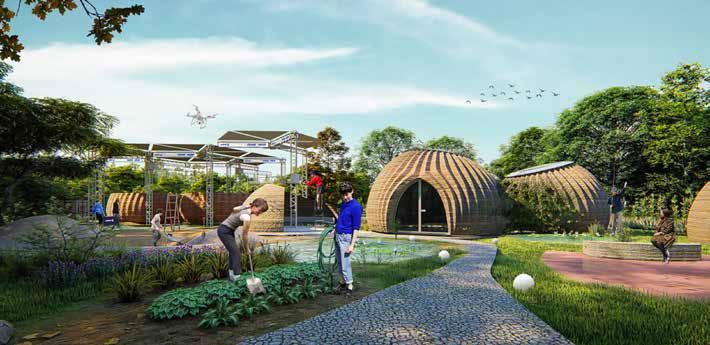
2 minute read
International Showcase: Italy
Landscape invited readers to submit their most inspiring ideas for addressing climate emergency. To start this new series, we present:
ITALY: TECLA – a 3D printed global habitat for sustainable living

Mario Cucinella Architects and WASP
It is currently estimated that 150 million people are homeless around the world, equating to 2% of the world’s population (Habitat for Humanity, 2015) 1 , whilst 1.6 billion people (20%) lack adequate housing for their psychological, social, physical and economic needs. The reasons are many – from poverty to housing shortages and from war to an increasing number of environmental emergencies – often in the poorest countries.
A United Nations report, published in 2017, states that the current global population of 7.6 billion people is expected to reach 11.2 billion in 2100 and in 2030 nearly 5 billion people are expected to live in cities. Consequently, governments are faced with substantial challenges related to housing solutions.
To respond to this challenge, WASP, Italy’s pioneering specialists in 3D printing, inspired by potter wasps which build their nests using locally sourced materials, has been developing viable construction processes based on the principles of circular economy. WASP create 3D printed houses in the shortest period of time and in the most sustainable way possible.

TECLA
© WASP
Mario Cucinella Architects has teamed up with WASP to embark on the development of an innovative model for a 3D printed habitat, just outside of Bologna in Italy. The intention was to create a fast-build, low-cost, flexible model that could then be applied in numerous different contexts around the world.
Their model has been named Tecla, after an imaginary city described by Italo Calvino in The Invisible Cities as a ‘continuous urban evolution’. It is representative of both companies’ efforts to combine technological innovation with a respect for the environment and an understanding of natural processes.
Borne from their collective vision to provide a home for everyone at a time of exponential population increase and an associated lack of affordable housing around the world, it is a new circular housing model, created using entirely reusable, recyclable materials taken from the local terrain. Tecla will be the first house to be entirely 3D printed using locally sourced clay – a biodegradable and recyclable ‘km 0 natural’ material which will effectively make the building zero-waste.
It will be built to adapt to multiple environments and it will be suitable for selfproduction through the use of WASP’s innovative Maker Economy Starter Kit. Built using Crane WASP, the latest innovation in on-site 3D construction, Tecla represents a step-change in the move towards eco-housing. It will be the first habitat to be built using multiple collaborative 3D printers, offering a greater scope of scale than ever before. The prototype is now in development and should be complete by the end of the year.
Tecla was developed using in-depth research undertaken by the School of Sustainability – a professional school founded by Mario Cucinella that combines education, research and practice. The research, conducted with the support of MA students from the Sustainable Environmental Design programme at the Architectural Association School of Architecture in London, explored the cause and effects of homelessness. It interrogated the use of technological advances to enable a solution, based on case studies in locations with different climates.








